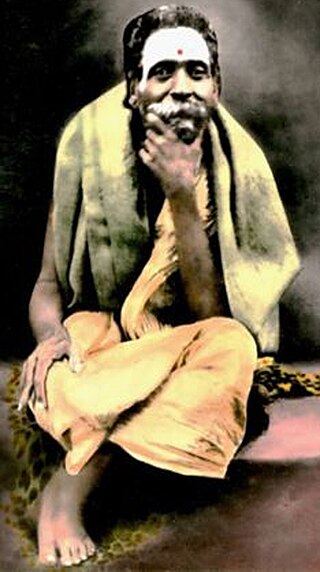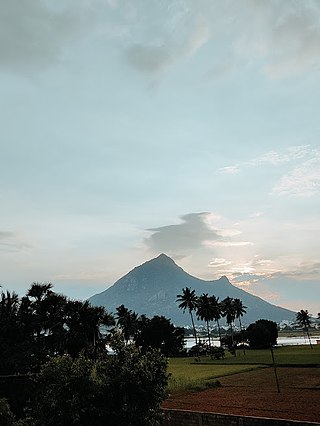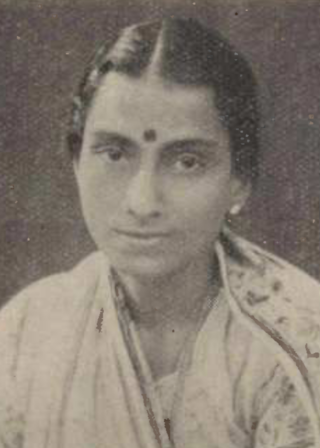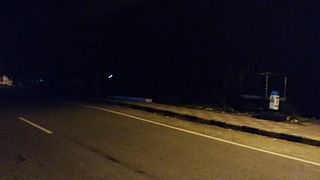
Ramana Maharshi was an Indian Hindu sage and jivanmukta. He was born Venkataraman Iyer, but is mostly known by the name Bhagavan Sri Ramana Maharshi.
Manavasi is a village in Southern Indian state of Tamil Nadu between the cities of Karur and Trichy. It is located in the Karur district. It is the location of the Toll Plaza on the Karur - Trichy Highway. One of the oldest Lord Shiva temple is located in Manavasi where Lord Shiva facing west direction. Kaasi, Avinashi and Manavasi is the places where Lord shiva statue facing west direction.

Sri Seshadri Swamigal, also known as the "Saint with a Golden Hand", was a male Indian saint born in Kanchipuram, Tamil Nadu, who predominantly lived in Thiruvannaamalai where he attained Samadhi.

Self-enquiry, also spelled self-inquiry, is the constant attention to the inner awareness of "I" or "I am" recommended by Ramana Maharshi as the most efficient and direct way of discovering the unreality of the "I"-thought.

Arunachalesvara Temple is a Hindu temple dedicated to the deity Shiva, located at the base of Arunachala hill in the town of Tiruvannamalai in Tamil Nadu, India. It is significant to the Hindu sect of Shaivism as one of the temples associated with the five elements, the Pancha Bhoota Stalas, and specifically the element of fire, or Agni.

Arunachala is a hill in Tiruvannamalai, Tamil Nadu, and one of the five main Shaiva holy places in South India. The Arunachalesvara Temple to Shiva is located at the base of the hill. The hill is also known by the names Annamalai, Arunagiri, Arunachalam, Arunai, Sonagiri, and Sonachalam.
A. R. Natarajan was a disciple of Sri Ramana Maharshi who published numerous books on his guru. He was the president and founder of the Ramana Maharshi Centre for Learning, Bangalore) the Bhagavan Sri Ramana Maharshi Research Centre and the vice-president of the Ramana Kendra, New Delhi."Bangaloreans would not have had the opportunity of learning about Bhagwan Shri Ramana, but for the efforts put by Shri.A.R.Natarajan in building RMCL at Mekhri Circle, Bangalore" said Mr.Shadakshari, a Great Devotee of Shri.Ramana Maharshi.Shri.A.R.Natarajan was the editor of the journal The Mountain Path, the official Publication of Sri Ramanashramam, Tiruvannamalai.. He authored several books on Sri Ramana Maharshi like "DIVINITY, HERE & NOW".
Yogi Ramsuratkumar was an Indian saint and mystic. He was also referred to as "Visiri samiyar" and spent most of his post-enlightenment period in Tiruvannamalai, a small town in Tamil Nadu which is famous for attracting spiritual seekers worldwide and has had a continuous lineage of enlightened souls. He acknowledges the contribution of three of the most well known saints of his time in his evolution to enlightenment. These individuals were Sri Aurobindo, the founder of Integral yoga, Ramana Maharshi, one of the "spiritual supermen" of his time, and Swami Ramdas, Yogi's eventual guru.

Nome is a spiritual teacher at Society of Abidance in Truth, known by the acronym SAT, which established and maintains a temple for nondual Self-knowledge in California. He expounds the teachings of Sri Ramana Maharshi and Advaita Vedanta. He, along with Dr. H. Ramamoorthy, translated into English the essential and classic work of Advaita Vedanta, "Ribhu Gita", which was highly recommended by Sri Ramana Maharshi. The English translation has been published by Society of Abidance in Truth and has since then been re-published by Sri Ramanasramam and translated into Hindi, Italian, Korean and German.

The Society of Abidance in Truth (SAT) is a spiritual nonprofit organization consecrated to the teachings of Advaita Vedanta, especially as revealed by Sri Ramana Maharshi.
Sri Ramana Ashram, also known as Sri Ramanasramam, is the ashram which was home to modern sage and Advaita Vedanta master Ramana Maharshi from 1922 until his death in 1950. It is situated at the foot of the Arunachala hill, to the west of Tiruvannamalai, Tamil Nadu, where thousands of seekers flocked to be in his presence. His samadhi shrine continues to attract devotees from all over the world.
Arthur Osborne was an English writer on spirituality and mysticism, and an influential disciple and biographer of Ramana Maharshi.

Neo-Advaita, also called the Satsang-movement is a new religious movement, emphasizing the direct recognition of the non-existence of the "I" or "ego," without the need of preparatory practice. Its teachings are derived from, but not authorised by, the teachings of the 20th century sage Ramana Maharshi, as interpreted and popularized by H. W. L. Poonja and several of his western students.

Robert Adams was an American Advaita teacher. In later life Adams held satsang with a small group of devotees in California, US. He mainly advocated the path of jñāna yoga with an emphasis on the practice of self-enquiry. Adams' teachings were not well known in his lifetime, but have since been widely circulated amongst those investigating the philosophy of Advaita and the Western devotees of Bhagavan Sri Ramana Maharshi. A book of his teachings, Silence of the Heart: Dialogues with Robert Adams, was published in 1999.
The Prabhu Linga Leelai Venpaas in Tamil written by Siva Prakasar also called as 'Siva anuputhi selvar, 'Karpanai Kalangiyam', 'Thurai mangalam Sivaprakasar'. He compiled more than thirty original works and few more translation works from Kannada and Sanskrit.
Ayyala Somayajulu Ganapathi Sastry, also known as Ganapati Muni (1878–1936), was a disciple of Ramana Maharshi. He was also variously known as "Kavyakantha", and "Nayana" by his disciples.

David Godman has written on the life, teachings and disciples of Ramana Maharshi, an Indian sage who lived and taught for more than fifty years at Arunachala, a sacred mountain in Tamil Nadu, India. In the last 30 years Godman has written or edited 16 books on topics related to Sri Ramana, his teachings and his followers.

Jiří Vacek was a Czech mystic, writer and translator of spiritual literature.

Lalita Venkatram, also credited as Lalita Venkataram or Lalitha Venkataraman, was an Indian Carnatic singer and veena player. She is credited as the first playback singer in Tamil cinema and the first Carnatic musician to be featured on All India Radio, Bombay.











